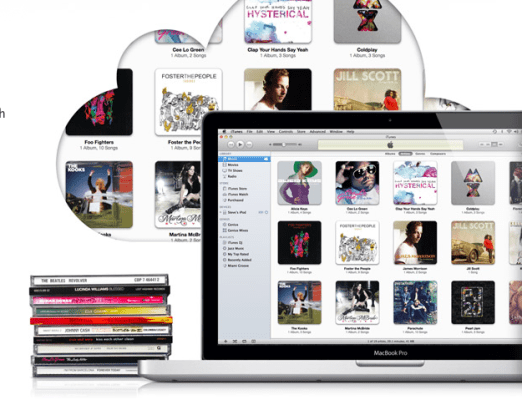Apple is rumored to be prepping a Pandora-like service providing virtual radio stations to users, according to the WSJ, and though it didn’t debut at this past week’s Apple event, I think there’s still a strong chance it’s coming. It’s not the same as an on-demand streamed music delivery like Spotify or Rdio, but it’s another step in that direction, and one that Apple has been slowly moving toward since it began offering digital music through iTunes in the first place.
Apple must, like the rest of us, see the writing on the wall for locally-stored tunes, and while convincing its licensing partners that the future is all-streaming might be a Herculean task, Pandora-style delivery is a natural progression for the iPhone maker in an attempt to get labels to swallow their medicine, bitter-tasting as it may be in the short term.
Just look back at how far Apple’s come, and the pattern becomes clear. In 2003, iTunes started selling music, having been just a music management tool for existing files since its introduction in 2001 before that — though it actually first shipped with support for Kerbango Internet radio, which was one of the earliest Pandora precursors (it still boasts its own selection of streaming radio stations, introduced in iTunes 2.0). It was a radically different way of consuming music, focused on the single track instead of on entire albums or EPs. Convincing labels to get on board with that, and with more or less uniform pricing, was one of Steve Jobs’ earliest and best magic tricks. It paved the way for all other online digital music sales models to come after it, including Amazon’s service, which is now a cornerstone of that company’s burgeoning approach to the competitive device market.
Just three years later in 2006, the iTunes store had sold 1 billion tracks, and then in 2007 EMI was the first label to go DRM-free on the store. There were still quite a few noteworthy hold-outs to the one-track-at-a-time purchase model back then, including Metallica, who got over it in 2006, and Radiohead, who gave in in 2008. And in fact some notables held out longer, including Jobs’ favorite The Beatles who came on board famously in 2010, and Bob Seger who came around in 2011. But the EMI decision to go DRM-free by and large started the flood: The entire iTunes catalog going DRM free in 2009, paving the way for still more freedom to open up just a few years later in terms of what users could do with their music.
Apple has allowed re-download of tracks purchased through the iTunes Store that were lost for one reason or another for a while now, although it was largely on a case-by-case basis. In March, it eased personal-use restrictions a little more with Home Sharing, where you could play back your local iTunes library on other devices attached to a local WiFi network. Then in June 2011 Apple introduced iCloud, with unlimited re-downloads of past purchases of iTunes Music, as well as optional Automatic Downloads across devices where you were signed in with your iTunes account. That likely wasn’t easy to sell to labels; in fact, in May 2011 I suggested that Apple was using the then-rumored service as a way to ease its label partners into the more dramatic idea of cloud-based music streaming.
Of course iCloud was just the foot in the door for iTunes Match, Apple’s cloud-based music locker that also seemed to act as a kind of paid legitimization service for users with lots of pirated content (though some noteworthy pirates disagreed on that point). It still wasn’t really a streaming service in the way that Spotify is; users could store their libraries in the cloud, but to play them back on their device simultaneously transferred them to local storage. It’s not clear whether that’s a feature, or a last concession to labels still gun shy of a 100 percent streaming service. On the desktop, however it does stream tracks, indicating that maybe Apple had the in-transit state of mobile devices and subsequent spotty wireless service in mind when it enforced downloads rather than anything else. Other recent developments that show a changing attitude toward streaming include free previews of entire albums, like Bob Dylan’s Tempest, which became available for full-length preview playback just over a week ago.
Still, iTunes Match wasn’t the streaming service many had predicted and hoped for. And a Pandora service isn’t quite that either, since it would provide radio — possibly with advertisements — customized for a user’s taste. And yes it would be streamed, but not the all-you-can eat access to the massive iTunes library that’s been a fever dream at least since Apple acquired Lala back in 2009. Make no mistake, Apple’s playing a long game here with labels, and the goal is iTunes everywhere, on a streaming, subscription basis. Framed in the context described above, a Pandora-style service makes perfect sense as Apple’s move toward that ultimate conclusion.
